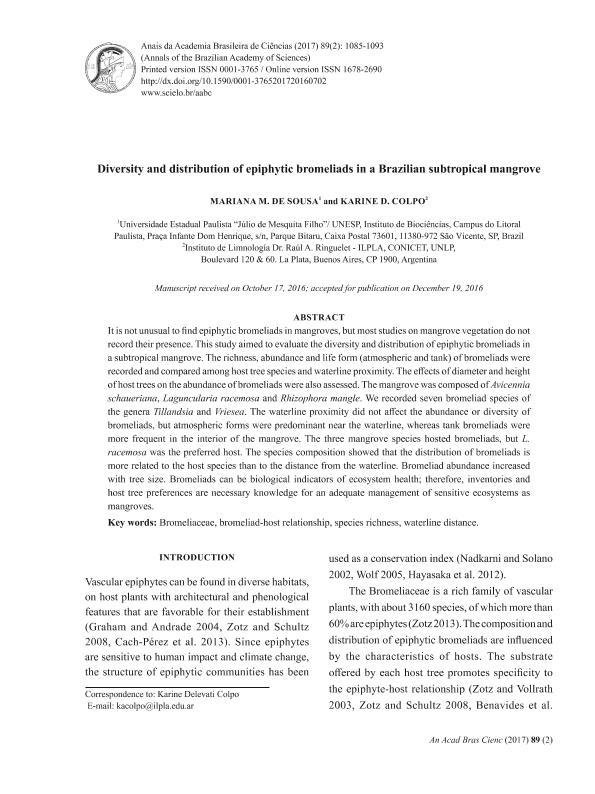Artículo
Diversity and distribution of epiphytic bromeliads in a Brazilian subtropical mangrove
Fecha de publicación:
06/2017
Editorial:
Academia Brasileira de Ciencias
Revista:
Anais da Academia Brasileira de Ciencias
ISSN:
0001-3765
e-ISSN:
1678-2690
Idioma:
Inglés
Tipo de recurso:
Artículo publicado
Clasificación temática:
Resumen
It is not unusual to find epiphytic bromeliads in mangroves, but most studies on mangrove vegetation do not record their presence. This study aimed to evaluate the diversity and distribution of epiphytic bromeliads in a subtropical mangrove. The richness, abundance and life form (atmospheric and tank) of bromeliads were recorded and compared among host tree species and waterline proximity. The effects of diameter and height of host trees on the abundance of bromeliads were also assessed. The mangrove was composed of Avicennia schaueriana, Laguncularia racemosa and Rhizophora mangle. We recorded seven bromeliad species of the genera Tillandsia and Vriesea. The waterline proximity did not affect the abundance or diversity of bromeliads, but atmospheric forms were predominant near the waterline, whereas tank bromeliads were more frequent in the interior of the mangrove. The three mangrove species hosted bromeliads, but L. racemosa was the preferred host. The species composition showed that the distribution of bromeliads is more related to the host species than to the distance from the waterline. Bromeliad abundance increased with tree size. Bromeliads can be biological indicators of ecosystem health; therefore, inventories and host tree preferences are necessary knowledge for an adequate management of sensitive ecosystems as mangroves.
Archivos asociados
Licencia
Identificadores
Colecciones
Articulos(ILPLA)
Articulos de INST.DE LIMNOLOGIA "DR. RAUL A. RINGUELET"
Articulos de INST.DE LIMNOLOGIA "DR. RAUL A. RINGUELET"
Citación
Sousa, Mariana De; Delevati Colpo, Karine; Diversity and distribution of epiphytic bromeliads in a Brazilian subtropical mangrove; Academia Brasileira de Ciencias; Anais da Academia Brasileira de Ciencias; 98; 2; 6-2017; 1085-1093
Compartir
Altmétricas




